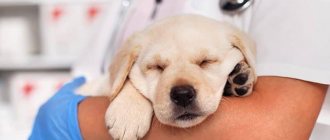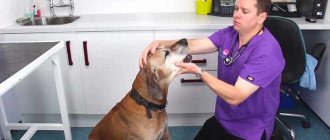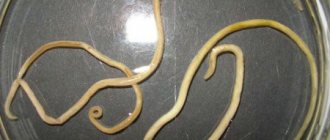Blood diseases in animals
- it's always serious.
One of the common ailments of the blood supply system, in which the normal number of red blood cells is reduced, as well as the level of the iron-containing protein hemoglobin is reduced, is considered anemia in dogs
or
anemia
- another name for this disease. With such a problem, the dog’s body does not receive enough oxygen, for the supply of which red blood cells and hemoglobin are responsible for the supply of which to the tissues, and the blood accumulates toxins and wastes. The causes, types, signs and treatment of anemia in pets will be discussed in today’s article.
Types of anemia in dogs
According to the factors of occurrence
These pathological processes are distinguished depending on the factors that caused their occurrence, into primary and secondary.
Primary anemia is caused by congenital disorders of the hematopoietic processes; this may be associated with abnormalities of the hematopoietic organs or with a genetic predisposition to autoimmune diseases (when antibodies are produced to the cells of one’s own body).
- Autoimmune hemolytic anemia.
Secondary are the result of some kind of illness or critical condition of the dog. Appear after a negative impact on the body.
By change in blood
Depending on the type of changes that occurred in the blood system, pathology is divided into:
Hemolytic anemia develops as a result of the destruction of red blood cells (hemolysis) under the influence of certain factors. This can also occur under the influence of chemicals, for example after taking certain medications.
Most often, the culprit of hemolytic anemia is a biological agent, namely blood parasites, which, after entering the body, begin to live and multiply inside red blood cells - erythrocytes, thereby destroying them.
The most striking example is canine piroplasmosis. In addition to blood parasites, this type of anemia can be caused by poison from insect or snake bites, as well as under the influence of viruses and bacteria. Physical factors such as high or low temperature and radiation also cause hemolysis of red blood cells.
Posthemorrhagic anemia develops as a result of significant blood loss as a result of injury to the vascular wall.
Trauma can be either external (for example, any injury) or internal (internal bleeding is especially dangerous, since in this case the blood clots much more slowly, and it is extremely difficult to diagnose internal bleeding, which means that a violation of the integrity of even small vessels can ultimately lead to to death).
- Acute posthemorrhagic anemia develops very rapidly due to damage to large blood vessels. Dogs have a very low resistance to blood loss compared to other animals. Losing 40% of blood for a dog can be incompatible with life.
- Chronic posthemorrhagic anemia occurs with small but frequent bleeding. This condition is most typical for gastric ulcers in dogs and with neoplasms (especially on the organs of the reproductive system).
Dyserythropoietic anemia occurs when there is insufficient formation of erythrocytes (red blood cells) in one of the main hematopoietic organs - the red bone marrow.
Regenerative anemia - the term means that the body is able to quickly compensate for the number of red blood cells by rapidly producing new cells.
Non-regenerative - and in this case the body is not able to cope on its own.
Aplastic anemias result from direct damage to red bone marrow stem cells—damage that can be caused by ionizing radiation. Or, which is more common, when the amount of microelements and vitamins necessary for the formation of red blood cells in the body is too small.
- Iron-deficiency anemia. Most often caused by a lack of iron in the diet, and in puppies by insufficient iron in the mother's milk. Another reason is impaired absorption of iron in diseases of the gastrointestinal tract, for example, gastric ulcers, gastritis, enteritis, etc.
- Folate deficiency anemia (lack of vitamin B12) develops due to insufficient intake of this vitamin from food.
When feeding dogs raw fish, especially whiting, pollock, saury and haddock, insoluble iron compounds are formed that cannot be absorbed by the animal, which provokes glandular anemia. To prevent this condition, it is recommended to boil fish!
Diagnostic measures
If anemia is suspected, a comprehensive examination is performed. The veterinarian analyzes the clinical picture and then prescribes tests. Diagnosis cannot be made without laboratory tests. It is necessary to take a blood sample to determine clotting. If anemia develops, the level of red blood cells is reduced, some changes in the structure. To confirm the diagnosis, bone marrow biochemistry is required. If the doctor suspects internal bleeding, he will prescribe laparocentesis. During the procedure, the abdominal cavity is punctured and several milliliters of abdominal fluid are removed using a needle.
If the veterinarian suspects a tumor or ulcer, he or she will perform an endoscopy. If oncology is suspected, a chest x-ray is prescribed. The prognosis depends on the cause of the disease; concomitant pathologies and symptoms are taken into account. If anemia is detected in a timely manner and the breeder adheres to the doctor’s recommendations, the prognosis is favorable. If the pathology arose as a result of serious poisoning or leukemia, the prognosis is disappointing.
Symptoms of anemia
Despite the variety of forms of anemia, the symptoms are always the same:
- The main thing is the pallor of the mucous membranes. You can detect this symptom by looking at the dog’s gums.
- Sometimes you can detect not pallor, but yellowing; this phenomenon is associated with the release of the bile pigment bilirubin, which means problems with the gastrointestinal tract can be assumed.
- Hemorrhages, hematomas.
- General weakness.
- The dog reacts very sluggishly to commands and, in general, to everything that happens around.
- The heart rate increases, but the pulse is faintly palpable.
- Shortness of breath, shallow breathing.
- Body temperature may be reduced.
- Appetite is weak or absent.
- The dog’s body’s immune defense drops, and viruses and infections begin to attack it.
- Anemia due to renal failure is accompanied by additional symptoms: blood appears in the urine, urination is frequent, and the dog drinks a lot and often.
Primary signs: what the owner may notice
The owner of a dog or cat will not be able to notice the very first signs of hemolytic anemia. Therefore, they, as a rule, go unnoticed, and animals arrive either with enhanced secondary signs or in critical condition.
What can be considered symptoms of hemolytic anemia:
- pallor of the mucous membranes, especially the gums, labial/cheek space. Normally, the color is pale pink; with anemia, it is porcelain-white. With hemolytic anemia, the mucous membranes become jaundiced;
- lethargy, apathy, drowsiness, exercise intolerance, depression;
- loss of interest in food to the point of giving it up, often accompanied by bloating;
- temperature is at the lower limit of normal or even lower.
With anemia of any origin, kidney problems, severe thirst, frequent urges, and excessive urination with a change in urine color may occur. Breathing is difficult, shallow, rapid heartbeat (this is how the body reacts to a lack of oxygen), blood pressure is reduced.
Visible symptoms are already an advanced problem! The onset of hemolytic anemia can be completely asymptomatic, so even a suspicion of malaise in a pet should be a reason to contact the Ros-Vet EC for a full examination. The clinic has its own laboratory, all tests are taken and done in the shortest possible time.
Diagnostics
This pathology is diagnosed using hematological analysis.
In blood counts, pay attention to:
Hemoglobin content. With anemia, this figure is reduced by 50 percent, and sometimes more.
The number of red blood cells is reduced (except for iron deficiency anemia, when this indicator is within the normal range). And the number of white blood cells (leukocytes) is normal.
The coloring of erythrocytes is disturbed and nonspecific forms appear, which clearly indicates pathology:
- anisocytosis - change in the size of red blood cells;
- poikilocytosis - change in shape;
- hyperchromic - bright coloring;
- hypochromic - weak color;
- polychromatophilia - coloring of red blood cells in a nonspecific color, for example, shades of blue or purple, instead of pink (normal);
- detect young forms of red blood cells - reticulocytes and erythroblasts.
By color, the veterinarian determines the degree of saturation of red blood cells with hemoglobin.
What tests are used to make a diagnosis?
There are several laboratory indicators by which a veterinarian can make a diagnosis with some accuracy. The process of destruction of red blood cells and blood loss may occur if there is:
- jaundice of tissues and mucous membranes due to a large amount of bilirubin entering the liver and not having time to be utilized. But liver failure must be excluded;
- spherocytes, old red blood cells, which the spleen does not have time to “eat”, but only “bites off” and sends further into the bloodstream. They are spherical in shape instead of the normal biconvex shape. Their presence indicates extensive pathological breakdown of red blood cells;
- autoagglutination in hemolytic anemia in dogs is observed when red blood cells covered with macrophages stick together. This sign is very unfavorable.
- leukemoid reaction, the number of leukocytes in the blood increases greatly.
All these laboratory tests are necessary and show how far the pathological process has gone. The veterinarian only needs to look at the results of a blood test to make a diagnosis.
Treatment
Treatment should be carried out by a veterinarian, so at the first signs of anemia (pallor and weakness), rush to the clinic!
- The first step is to stop the bleeding if the anemia is caused by vascular damage.
- A dropper with a special solution is required. If the blood loss is not great, then it is enough to intravenously administer saline solution (sodium chloride 0.9%), glucose, or Ringer's solution. For more significant blood losses, special medications are added to the saline solution. And in the most severe cases, you may need a blood transfusion from a healthy dog!
- Eliminate the original cause of anemia.
- Symptomatic therapy is carried out.
- Prescribe vitamins (especially B12) and essential microelements for better hematopoiesis.
- Drugs are prescribed to normalize blood composition.
- It is necessary to treat the dog for parasites, especially if there is a suspicion that they were the cause of the pathology.
Diet
The diet for anemia consists of a balanced and proper diet. When feeding dogs with specialized industrial food, anemia will not occur. But if you feed your dog from the table, vegetarian diets, then problems cannot be avoided. Canned baby food, so beloved by many owners, is especially dangerous for dogs - it often contains onions and garlic in quantities allowed for children to enhance the taste, but in dogs they can cause hemolytic anemia. It is also strictly forbidden to add onions and garlic to food: eating onions or garlic in an amount of 5 g/kg of body weight is a toxic dose and can lead to severe anemia.
FAQ
How can I help my dog with progressive anemia?
The best help in this case is to contact a veterinary clinic to have your pet examined. If anemia progresses due to large blood loss, you can help find a blood donor for your pet. Among our four-legged friends there are also donors, it is important to know about this.
Why are dogs tested for anemia?
This test is necessary not just to diagnose anemia, but also to determine the stage of the pathology and decide on further action.
How dangerous is the condition?
In addition to the inevitable death from oxygen starvation or massive failure of internal organs, the danger lies in a sharp weakening of the immune system. Because of this, a deficiency of red blood cells often leads to exacerbation of chronic pathologies and the addition of secondary infections.
If the disease occurs during pregnancy, the threat also extends to puppies. They either die almost immediately inside the womb or suffer developmental delays.
Briefly about the main thing
- Anemia is anemia. This pathology of the blood system is characterized by a decrease in the amount of hemoglobin in the blood and red blood cells.
- Most often it is a symptom of a primary disease, and not an independent disease.
- Types of anemia are distinguished from each other depending on their origin.
- Despite the types of anemia, the clinical signs are always the same. The main symptoms are pale mucous membranes and lethargy.
- Treatment always requires a drip, and this is only possible in a clinical setting.
- All dogs may be at risk.
- To prevent this condition in your pet, you need to monitor its diet, vaccinate it and treat it against parasites.
Reasons for development
Anemia (anemia) is not so much an independent disease as a symptom of other disorders in the body. It can be provoked by:
- Serious pathologies or injuries accompanied by heavy bleeding.
- Autoimmune pathologies, when the body begins to destroy its own red blood cells.
- Poisoning with heavy metals or poisons that cause severe intoxication of the body.
- Gastrointestinal diseases that cause bleeding.
- Using medications that may have internal bleeding as a side effect (non-steroidal anti-inflammatory drugs).
- Infectious diseases that provoke hemorrhages in the gastrointestinal tract (viral hepatitis, piroplasmosis, leptospirosis, etc.).
- Advanced forms of damage by external and internal parasites (especially in small breeds or young individuals).
- Chronic diseases of the liver and kidneys, causing disturbances in cellular blood parameters.
- Congenital pathologies of the hematopoietic system and blood clotting processes.
- Unbalanced diet.
- Ulcerations and bleeding tumors in cancer.
Risk group
The development of anemia is possible in all dogs, regardless of age and breed. Greyhounds and pit bull terriers are included in a separate risk group. These two breeds are characterized by a more severe course of infectious diseases that can cause anemia.
In addition, the risk of anemia increases significantly for animals with duodenal or gastric ulcers and hereditary pathologies.











